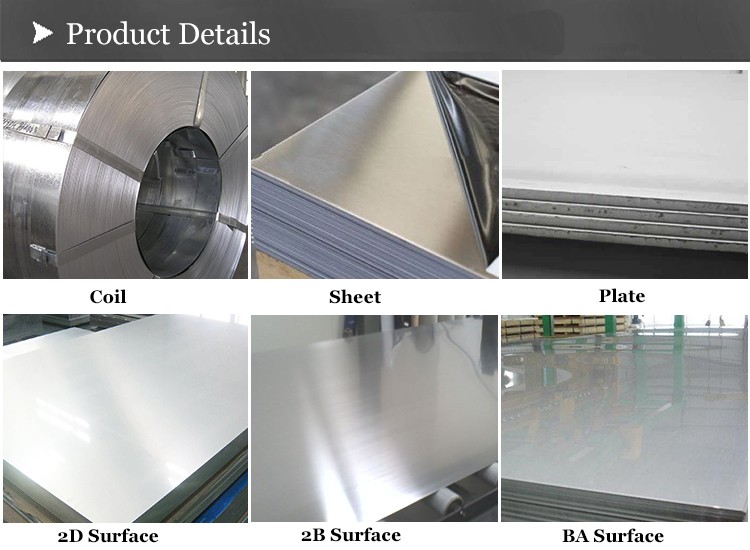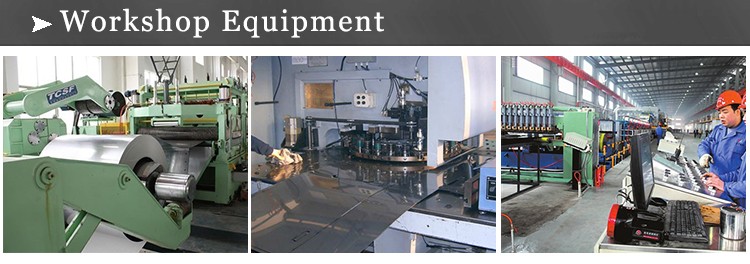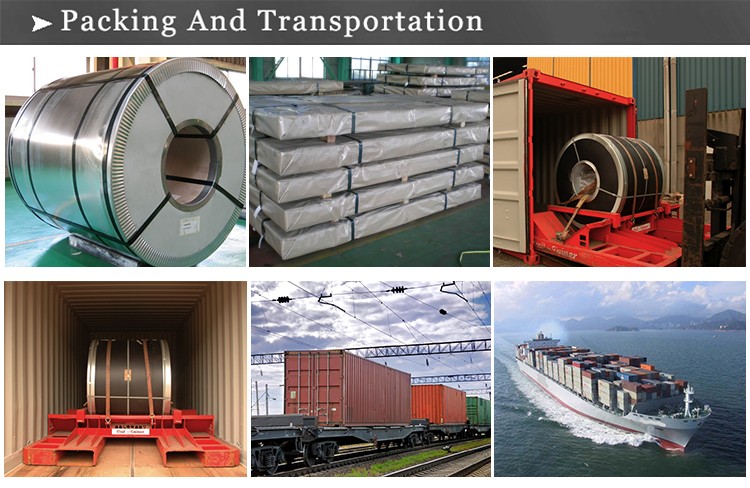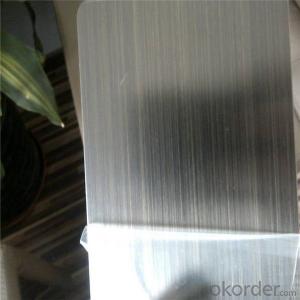Stainless steel sheet,440C (9Cr18MoV) in China
- Loading Port:
- Shanghai
- Payment Terms:
- TT OR LC
- Min Order Qty:
- 2 m.t.
- Supply Capability:
- 20000 m.t./month
OKorder Service Pledge
Quality Product, Order Online Tracking, Timely Delivery
OKorder Financial Service
Credit Rating, Credit Services, Credit Purchasing
You Might Also Like
Item specifice
Standard:
ASTM
Technique:
Cold Rolled
Shape:
Square
Surface Treatment:
Polished
Steel Grade:
300 Series
Certification:
SGS
Thickness:
3
Width:
1500
Length:
3000
Net Weight:
25
Product Description

![]()
| Name | Stainless steel sheet,440C (9Cr18MoV),N695 Hardness:55-60Hrc |
| Standard | ASTM A276, JIS G4303, AS 2837 |
| Material Grade | W.Nr 1.4125 , X105CrMo17, 440C , 9Cr18MoV, SAE 51440C , UNS S44004 |
| Technique | Cold Rolled |
| Thickness | 0.1mm-200mm or as your requirement |
| Width | 1000mm-3000mm or as your requirement |
| Length | As your requirement |
| Surface Treatment | No.1,2B,2D,BA, or as your needs |
| Packing | 1. Export sea worthy package + water proof paper + wooden pallet |
| 2. Max Loading 26.5mt for each 20Gp container | |
| 3.Safe loading and fixing Professional Teams | |
| 4. Professional shipping line | |
| Delivery | According to the order quantity or upon negotiation |
| Application | Stainless Steel Coils are widely used in below fields: |
| 1: Construction field, shipping building industry | |
| 2: Pipe weldeding | |
| 3: Food and Mechanical Industries | |
| Quality control | Mill Test Certificate is supplied with shipment |
| Accept any third party inspection |

Qulity Control
Third party inspection that is preferred by new customers are proved to be convincing. Through years' of operation, M/S Chengdu Derbo has established stable contact with world famous third party inspection authorities like BV, SGS, INTERTEK, etc, and more than 5000M.Tons of steel pipes/tubes from Chengdu Derbo have been inspected by them.
Packaging & Shipping


- Q:How do you prevent fingerprints or smudges on stainless steel sheets?
- There are several effective measures you can take to prevent fingerprints or smudges on stainless steel sheets: 1. Regularly wipe down the stainless steel surface with a soft microfiber cloth. Microfiber is great at attracting and trapping dirt, dust, and oils without leaving streaks or smudges. 2. Use warm soapy water to gently clean the stainless steel surface. Mix a small amount of mild dish soap with warm water, then rinse thoroughly and dry with a clean towel. This method effectively removes grease, fingerprints, and smudges. 3. Consider investing in stainless steel cleaners that are specifically formulated to remove fingerprints and smudges. Follow the instructions on the product for best results. 4. Apply a stainless steel protective coating or sealant to create a thin, invisible barrier that repels fingerprints and smudges. Follow the manufacturer's instructions for application and reapply as needed. 5. Avoid using abrasive cleaners, scrub brushes, steel wool, or harsh chemicals that can damage the protective layer of stainless steel. Stick to non-abrasive cleaning methods and tools to maintain the integrity of the surface. 6. Handle stainless steel sheets with care by using clean hands or wearing gloves to prevent the transfer of oils or dirt. Avoid dragging objects across the surface, as this can cause scratches and make it more susceptible to smudging. By incorporating these measures into your cleaning routine and handling practices, you can effectively minimize fingerprints and smudges on your stainless steel sheets, keeping them clean and pristine.
- Q:What are the limitations of using stainless steel sheets?
- Some limitations of using stainless steel sheets include their high initial cost, susceptibility to scratching, potential for corrosion in certain environments, and difficulty in shaping complex designs. Additionally, stainless steel sheets are relatively heavy, which can be a disadvantage in certain applications where weight is a concern.
- Q:Can stainless steel sheets be cold rolled?
- Yes, stainless steel sheets can be cold rolled. Cold rolling is a process in which a stainless steel sheet is passed through a series of rollers at room temperature, reducing its thickness and increasing its hardness and strength. This process can be used to produce stainless steel sheets with precise dimensions and surface finishes. Cold rolling is commonly used in the manufacturing of stainless steel sheets for various applications such as automotive components, kitchen appliances, and architectural structures.
- Q:What are the benefits of using mirror-finish stainless steel sheets?
- There are several benefits to using mirror-finish stainless steel sheets in various applications. Firstly, the mirror-like surface of these sheets adds a touch of elegance and style to any space. Whether it is used in interior design, architecture, or decorative pieces, the reflective nature of the mirror finish enhances the overall aesthetic appeal. Additionally, mirror-finish stainless steel sheets offer exceptional durability and longevity. The high-quality stainless steel material used in their production ensures resistance to corrosion, rust, and staining, making them suitable for both indoor and outdoor use. This quality also makes them easy to clean and maintain, saving time and effort in upkeep. Another advantage of mirror-finish stainless steel sheets is their ability to reflect light. This characteristic makes them an excellent choice for spaces that require enhanced lighting or for applications where light distribution is essential. The reflective surface helps to brighten up the environment, making it ideal for areas such as kitchens, bathrooms, and commercial spaces. Moreover, mirror-finish stainless steel sheets are highly versatile and can be used in a wide range of applications. From countertops and backsplashes in kitchens to wall claddings, elevator interiors, and even custom-made furniture, their versatility allows for creative and unique designs in various industries. Furthermore, mirror-finish stainless steel sheets have excellent heat resistance properties, making them suitable for applications that involve high temperatures. This feature makes them a popular choice in commercial kitchens, industrial settings, and other environments where heat exposure is a concern. Lastly, mirror-finish stainless steel sheets are an environmentally friendly option. Stainless steel is highly recyclable, and using mirror-finish sheets promotes sustainability by reducing the need for new materials. This aspect aligns with the growing emphasis on eco-friendly practices and the desire to reduce the carbon footprint. In conclusion, the benefits of using mirror-finish stainless steel sheets include their elegant appearance, durability, light reflection capabilities, versatility, heat resistance, and eco-friendliness. These qualities make them a desirable choice for various applications, providing both aesthetic appeal and functional advantages.
- Q:What are the different types of stainless steel sheet edges?
- The different types of stainless steel sheet edges include mill edge, slit edge, deburred edge, rounded edge, and beveled edge.
- Q:Are stainless steel sheets suitable for oil and gas applications?
- Yes, stainless steel sheets are suitable for oil and gas applications. Stainless steel is known for its excellent corrosion resistance, making it highly suitable for use in harsh environments such as those found in the oil and gas industry. It can withstand exposure to a wide range of corrosive substances, including acids, alkalis, and saltwater, without deteriorating or corroding. Additionally, stainless steel has high strength and durability, making it capable of withstanding high-pressure conditions typically encountered in oil and gas operations. It is also resistant to high temperatures, which is important in applications where heat resistance is required. Furthermore, stainless steel sheets can be easily fabricated and shaped to meet specific design requirements, allowing for flexibility in engineering and construction. Overall, the combination of corrosion resistance, strength, and versatility makes stainless steel sheets an excellent choice for use in oil and gas applications.
- Q:How do you prevent discoloration or staining on stainless steel sheets?
- To prevent discoloration or staining on stainless steel sheets, there are several steps you can take: 1. Regular Cleaning: Clean the stainless steel sheets regularly using mild soap or detergent and warm water. Avoid using abrasive cleaners or scrub brushes that can scratch the surface. After cleaning, rinse thoroughly with clean water and dry with a soft cloth to prevent water spots. 2. Avoid Harsh Chemicals: Avoid using harsh chemicals such as bleach, ammonia, or chlorine-based cleaners on stainless steel sheets. These chemicals can cause discoloration or staining. Instead, opt for stainless steel-specific cleaners or natural cleaners like vinegar or lemon juice. 3. Proper Storage: Store stainless steel sheets in a clean and dry environment to avoid exposure to moisture or humidity. Moisture can lead to corrosion or rust, which can cause discoloration. If the sheets are stored outdoors, cover them properly to protect them from rain or snow. 4. Use Protective Coatings: Applying a protective coating or sealant on stainless steel sheets can help prevent discoloration or staining. There are various products available in the market specifically designed for stainless steel protection. Follow the manufacturer's instructions for application and reapplication, if necessary. 5. Avoid Contact with Reactive Metals: Avoid contact between stainless steel sheets and other reactive metals such as iron, copper, or aluminum. When these metals come into contact with stainless steel, a chemical reaction called galvanic corrosion can occur, leading to discoloration and staining. Ensure separation or isolation between stainless steel and reactive metals. 6. Regular Maintenance: Regularly inspect the stainless steel sheets for any signs of discoloration, staining, or damage. Address any issues promptly to prevent further deterioration. If you notice any stubborn stains, use a non-abrasive stainless steel cleaner and a soft cloth to gently rub the affected area in the direction of the grain. By following these preventive measures, you can maintain the appearance and integrity of stainless steel sheets, ensuring they remain free from discoloration or staining for an extended period.
- Q:Are stainless steel sheets resistant to radiation?
- Generally speaking, stainless steel sheets exhibit a high level of resistance to radiation. This is because stainless steel is renowned for its ability to withstand corrosion and oxidation, making it a suitable choice for industries that deal with radiation exposure, such as nuclear power plants, medical facilities, and laboratories. The resistance to radiation exhibited by stainless steel can be attributed to its composition, which includes chromium, nickel, and other alloying elements. These elements create a protective oxide layer on the surface of the stainless steel, effectively preventing radiation from penetrating the material. However, it is important to note that the degree of radiation resistance can vary depending on the specific grade and thickness of the stainless steel sheet. To ensure optimal performance in radiation-prone environments, it is recommended to seek advice from experts or consult specific technical specifications.
- Q:Can stainless steel sheets be used for heat transfer applications?
- Yes, stainless steel sheets can be used for heat transfer applications. Stainless steel has excellent thermal conductivity, making it suitable for transferring heat efficiently between two surfaces or mediums. It is commonly used in heat exchangers, cookware, and other applications where heat transfer is essential.
- Q:Stainless steel wire drawing without fingerprints, what principle?
- As for sandblasting, the surface roughness is higher than the wire drawing, and the stainless steel has no gloss (which makes the customer fail to see the stainless steel parts and sometimes lower the grade). Liquid blasting is recommended to achieve relatively better surface treatment results.Commercial kitchen experts completely hand, no copy paste. Please give favorable comments.
1. Manufacturer Overview |
|
|---|---|
| Location | |
| Year Established | |
| Annual Output Value | |
| Main Markets | |
| Company Certifications | |
2. Manufacturer Certificates |
|
|---|---|
| a) Certification Name | |
| Range | |
| Reference | |
| Validity Period | |
3. Manufacturer Capability |
|
|---|---|
| a)Trade Capacity | |
| Nearest Port | |
| Export Percentage | |
| No.of Employees in Trade Department | |
| Language Spoken: | |
| b)Factory Information | |
| Factory Size: | |
| No. of Production Lines | |
| Contract Manufacturing | |
| Product Price Range | |
Send your message to us
Stainless steel sheet,440C (9Cr18MoV) in China
- Loading Port:
- Shanghai
- Payment Terms:
- TT OR LC
- Min Order Qty:
- 2 m.t.
- Supply Capability:
- 20000 m.t./month
OKorder Service Pledge
Quality Product, Order Online Tracking, Timely Delivery
OKorder Financial Service
Credit Rating, Credit Services, Credit Purchasing
Similar products
New products
Hot products
Hot Searches
Related keywords





























